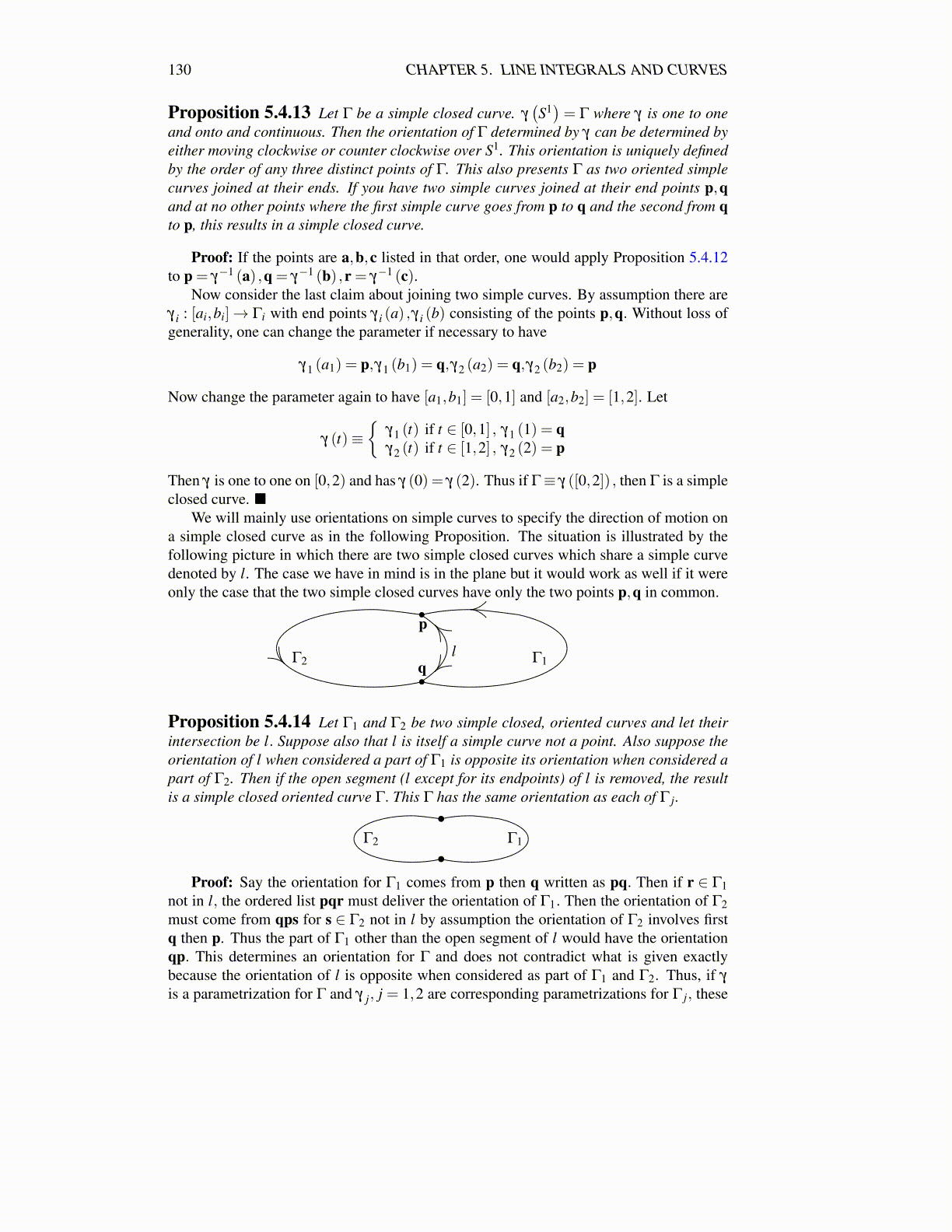
130 CHAPTER 5. LINE INTEGRALS AND CURVES
Proposition 5.4.13 Let Γ be a simple closed curve. γ(S1)= Γ where γ is one to one
and onto and continuous. Then the orientation of Γ determined by γ can be determined byeither moving clockwise or counter clockwise over S1. This orientation is uniquely definedby the order of any three distinct points of Γ. This also presents Γ as two oriented simplecurves joined at their ends. If you have two simple curves joined at their end points p,qand at no other points where the first simple curve goes from p to q and the second from qto p, this results in a simple closed curve.
Proof: If the points are a,b,c listed in that order, one would apply Proposition 5.4.12to p = γ−1 (a) ,q = γ−1 (b) ,r = γ−1 (c).
Now consider the last claim about joining two simple curves. By assumption there areγ i : [ai,bi]→ Γi with end points γ i (a) ,γ i (b) consisting of the points p,q. Without loss ofgenerality, one can change the parameter if necessary to have
γ1 (a1) = p,γ1 (b1) = q,γ2 (a2) = q,γ2 (b2) = p
Now change the parameter again to have [a1,b1] = [0,1] and [a2,b2] = [1,2]. Let
γ (t)≡{
γ1 (t) if t ∈ [0,1] , γ1 (1) = qγ2 (t) if t ∈ [1,2] , γ2 (2) = p
Then γ is one to one on [0,2) and has γ (0) = γ (2). Thus if Γ≡ γ ([0,2]) , then Γ is a simpleclosed curve. ■
We will mainly use orientations on simple curves to specify the direction of motion ona simple closed curve as in the following Proposition. The situation is illustrated by thefollowing picture in which there are two simple closed curves which share a simple curvedenoted by l. The case we have in mind is in the plane but it would work as well if it wereonly the case that the two simple closed curves have only the two points p,q in common.
p
qΓ1Γ2
l
Proposition 5.4.14 Let Γ1 and Γ2 be two simple closed, oriented curves and let theirintersection be l. Suppose also that l is itself a simple curve not a point. Also suppose theorientation of l when considered a part of Γ1 is opposite its orientation when considered apart of Γ2. Then if the open segment (l except for its endpoints) of l is removed, the resultis a simple closed oriented curve Γ. This Γ has the same orientation as each of Γ j.
Γ1Γ2
Proof: Say the orientation for Γ1 comes from p then q written as pq. Then if r ∈ Γ1not in l, the ordered list pqr must deliver the orientation of Γ1. Then the orientation of Γ2must come from qps for s ∈ Γ2 not in l by assumption the orientation of Γ2 involves firstq then p. Thus the part of Γ1 other than the open segment of l would have the orientationqp. This determines an orientation for Γ and does not contradict what is given exactlybecause the orientation of l is opposite when considered as part of Γ1 and Γ2. Thus, if γ
is a parametrization for Γ and γ j, j = 1,2 are corresponding parametrizations for Γ j, these